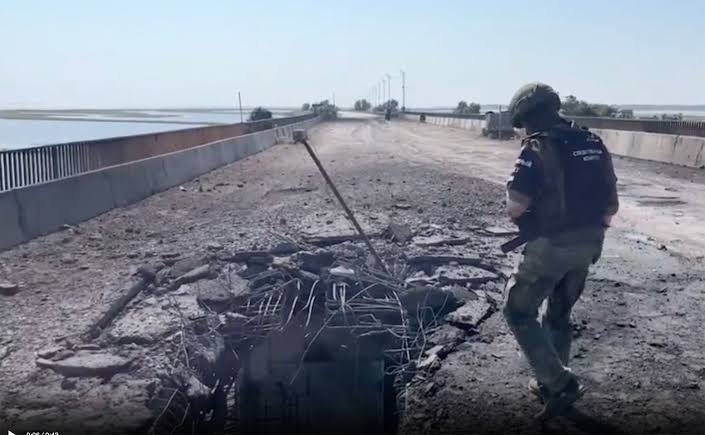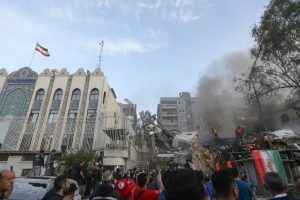
Ukrainian Forces Strike Strategic Bridges in Kursk region of Russia
Political arrogance is a double-edged sword—those who crush their opponents today may find themselves in the same position tomorrow. With audacity, Ukrainian forces have destroyed a second strategic bridge in Russia’s Kursk region, intensifying their military operations against Russian infrastructure. This latest strike targeted a bridge over the Seym River in Zvannoe, aiming to disrupt Russian supply lines and logistics capabilities. It is part of a broader Ukrainian strategy to exert operational and strategic pressure on Russian forces.
Details of the Strikes
Recent aerial footage confirms the destruction of the bridge. Lt Gen Mykola Oleschuk, the Ukrainian Air Force commander, verified the strike on social media, stating, “Minus one more bridge!” This bridge was one of three crucial crossings used by Russia to supply its troops. With two now destroyed or severely damaged, Russian logistical operations in the Kursk Oblast have been significantly hampered. The destruction follows an earlier attack on a road bridge in the Glushkovsky district. Ukrainian strikes have left the Russian military with only one bridge in the district, severely limiting Moscow’s resupply capabilities.
Ukrainian Strategic Objectives
Ukrainian operations aim to destroy Russia’s war potential by impairing military effectiveness. A key goal is to create a buffer zone within Russian territory to prevent further cross-border attacks and enhance the security of Ukrainian communities, particularly in the Sumy region. By targeting critical infrastructure like bridges, Ukraine seeks to disrupt Russian supply lines and complicate military logistics. Instead of focusing solely on territorial gains, Ukraine aims to apply strategic pressure to undermine Russian operational capabilities.
Factors Contributing to Russia’s Difficulty in Responding
Several factors have hindered Russia’s response:
1. Logistical Overstretch: Russia’s military logistics are overstretched. The scale of the Ukrainian offensive and the need to reallocate resources strain Russia’s supply lines and operational readiness.
2. Surprise and Intelligence: Ukraine’s operation has caught Russia by surprise, revealing gaps in intelligence and preparedness. Ukrainian forces exploited areas where Russia was less prepared, leading to a chaotic response from Russian military leadership.
3. Internal Military Challenges: Russia’s military faces criticism for poor planning and low combat readiness. Outdated equipment and logistical difficulties have hindered effective defence.
Domestic Impact in Russia Due to the Kursk Attacks
The recent attacks in the Kursk region have led to significant domestic consequences, particularly in terms of evacuations and military responses.
In response to the escalating situation, Russian authorities have declared a federal-level emergency in the Kursk region. Reports indicate that “over 76,000 people have been evacuated” from Kursk due to the ongoing conflict, marking one of the largest evacuations in the area since the start of the war. Additionally, the neighbouring Belgorod region has also seen evacuations, with around “11,000 people moved” from there as well.
The Russian Defence Ministry has deployed additional troops and heavy armour to the Kursk region, emphasising the seriousness of the situation. A counter-terrorist operation has been initiated, granting local authorities enhanced powers to restrict movement and conduct temporary evacuations. Reports suggest that Ukrainian forces have advanced significantly into Russian territory, with some estimates indicating incursions of up to “35 kilometres (20 miles)”.
The conflict has resulted in civilian casualties, with reports of at least five deaths and numerous injuries among the local population. Social services and civic organisations are actively assisting those displaced by the fighting, highlighting the humanitarian aspect of the crisis.
Overall, the situation in the Kursk region reflects a significant escalation in the conflict, with profound implications for both military strategy and civilian life in the affected areas.
Strategic Considerations for Russia
Russia’s military strategy in the ongoing conflict with Ukraine is shaped by several critical considerations:
1. Resource Allocation: Russia faces the challenge of effectively allocating its military resources. As it redirects forces to counter Ukrainian offensives, it must divert resources from other fronts, which can hinder its broader military objectives.
2. Operational Balance: Maintaining a balance between defending its territory and conducting operations elsewhere complicates Russia’s military response. This dual focus can dilute its effectiveness in both areas.
3. Public Perception: The Russian government is highly cautious about how it presents the conflict to its citizens. Acknowledging the full scale of the Ukrainian offensive and its consequences could undermine public support and increase domestic pressure on the government.
Future Implications
The ongoing conflict and Ukrainian attacks on Russian infrastructure may lead to several long-term implications:
1. Regional Stability: Continued military operations and potential escalations could exacerbate tensions in Eastern Europe, impacting overall regional stability and security.
2. Geopolitical Shifts: The conflict is likely to influence geopolitical alignments in Eastern Europe, as countries reassess their security strategies in light of the evolving situation.
3. Military Strategy Adaptations: Both Ukrainian and Russian forces are expected to adapt their military strategies based on battlefield developments and international reactions. This adaptability will shape the future course of the conflict.
Russia’s strategic considerations are deeply intertwined with its operational capabilities and the broader geopolitical landscape, while the implications of the conflict extend beyond immediate military outcomes, affecting regional stability and international relations.
Conclusion
As the dust settles over the smouldering remains of strategic bridges in the Kursk region, the impact of the conflict on Ukraine, Russia, and their people becomes clear. This struggle is more than a battle for territory; it profoundly affects families, communities, and nations. The destruction of infrastructure serves military goals but deeply impacts civilian lives.
In Ukraine, the resilience of its citizens shines through. Each strike against Russian supply lines is a testament to a nation fighting for its sovereignty and future. The sacrifices reflect a longing for peace, stability, and rebuilding.
Conversely, Russian military operations affect its citizens deeply. The evacuation of hundreds of thousands from the Kursk region reveals growing anxiety and fear. Despite political narratives projecting strength, the reality is a populace facing uncertainty, which can fracture society.
This conflict underscores that war knows no boundaries, and its toll is felt by all. Innocent people suffer, families are torn apart, and the scars of battle linger long after the last shot is fired. As both nations navigate this turbulent path, it is crucial to remember the shared humanity that binds them.
Aric Jabari is a Fellow at the Sixteenth Council



